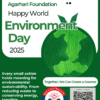Wastewater cut the Lifeline of Yamuna in Delhi: A River in Crisis, A Lifeline Lost
The Yamuna River, with significant holy river meets at Sangam at Prayagraj Maha Kumbh once considered the lifeline of Delhi, has now been declared almost non-existent in its ability to sustain life. A recent parliamentary report has painted a grim picture of the river’s condition, highlighting the alarming levels of pollution that have rendered it incapable of supporting aquatic ecosystems or providing safe drinking water. Out of 33 monitored sites along the river, 23—including six within the national capital NCT—failed to meet even the basic water quality standards.
The Vanishing Lifeline:
The first sight of the Yamuna in Delhi is enough to shock anyone. What was once a flowing river of life now appearing as a black, stagnant mass of filth, emitting an unbearable stench. The 40-km stretch of the Yamuna passing through Delhi, from Palla at the Haryana border to Asgarpur in Uttar Pradesh, has become an ecological dead zone. Dissolved oxygen (DO) levels, a key indicator of a water body’s ability to sustain life, are nearly absent in this stretch, signifying that aquatic flora and fauna can no longer thrive.
Despite multiple sewage treatment plants (STPs) being constructed and upgraded in both Delhi and Uttar Pradesh, the river continues to deteriorate. The primary culprits remain unchecked industrial discharge, untreated sewage, and rampant encroachments along the riverbanks.
Reasons Behind the Crisis
- Unregulated Sewage and Industrial Effluents:
Delhi alone generates thousands of millions of liters of sewage daily, much of which flows untreated into the Yamuna. Industrial units also discharge toxic chemicals into the river, adding to the pollution load. - Lack of Effective Water Management
The Upper Yamuna River Cleaning Project has failed to yield tangible results due to poor coordination among state governments and implementing agencies. The absence of stringent monitoring and enforcement mechanisms has allowed pollution to persist. - Reduced Natural Flow
Excessive water extraction for irrigation, industrial use, and drinking water supply has left the Yamuna with little natural flow to dilute pollutants. Barrages and dams upstream have further reduced the river’s self-cleaning capacity. - Encroachments and Dumping
Illegal settlements, sand mining, and direct dumping of solid waste into the river have choked its course, leaving it stagnant and unfit for natural purification.
The Drinking Water Crisis:
The impact of the Yamuna’s deterioration extends beyond aquatic life—it directly affects millions who rely on it for drinking water. Despite treatment, pollutants such as heavy metals, bacteria, and toxins make their way into household water supplies, posing severe health risks.
A Call for Urgent Action:
The parliamentary standing committee has emphasized the need for a coordinated multi-state effort to combat the crisis. Some key recommendations include:
- Strict enforcement of pollution control norms for industries and municipal bodies.
- Upgrading and expanding sewage treatment infrastructure to handle the growing urban population.
- Ensuring environmental flow by regulating water extraction and allowing natural self-cleansing mechanisms to function.
- Public participation and awareness to prevent further degradation.
Without immediate intervention, the Yamuna risks becoming an irreversibly lost water resource for Delhi. Reviving the river is not just an environmental necessity but a matter of survival for the city and its people.






